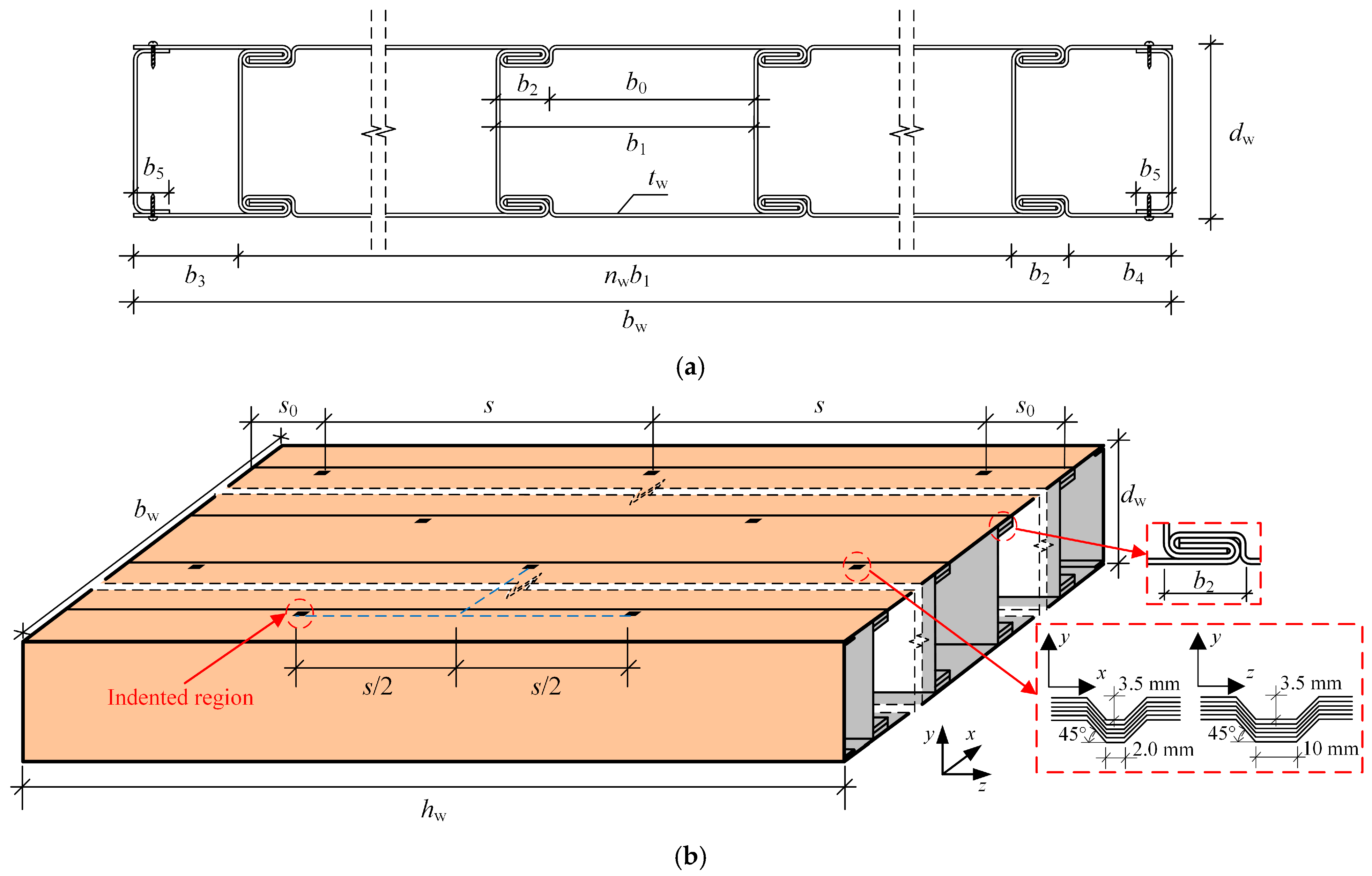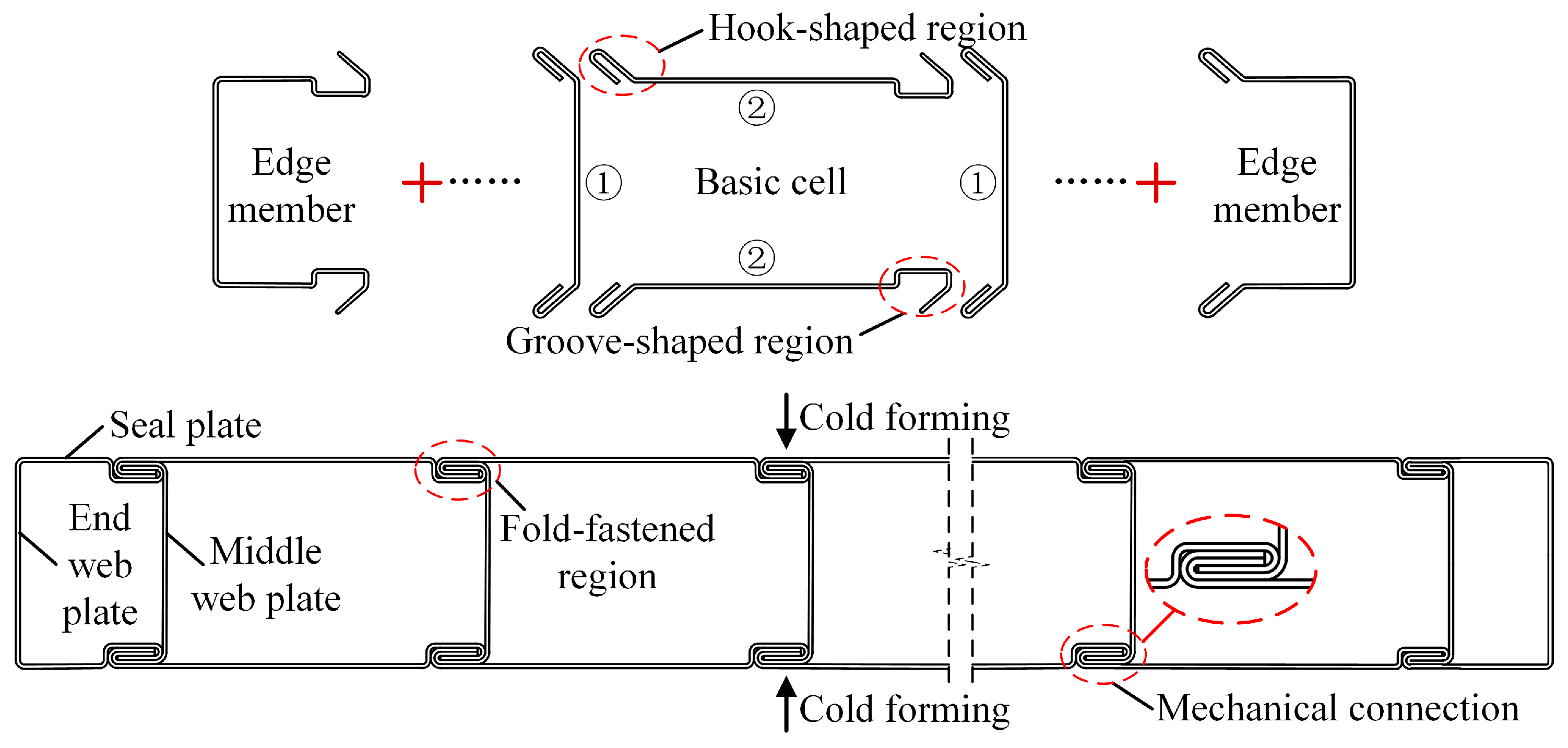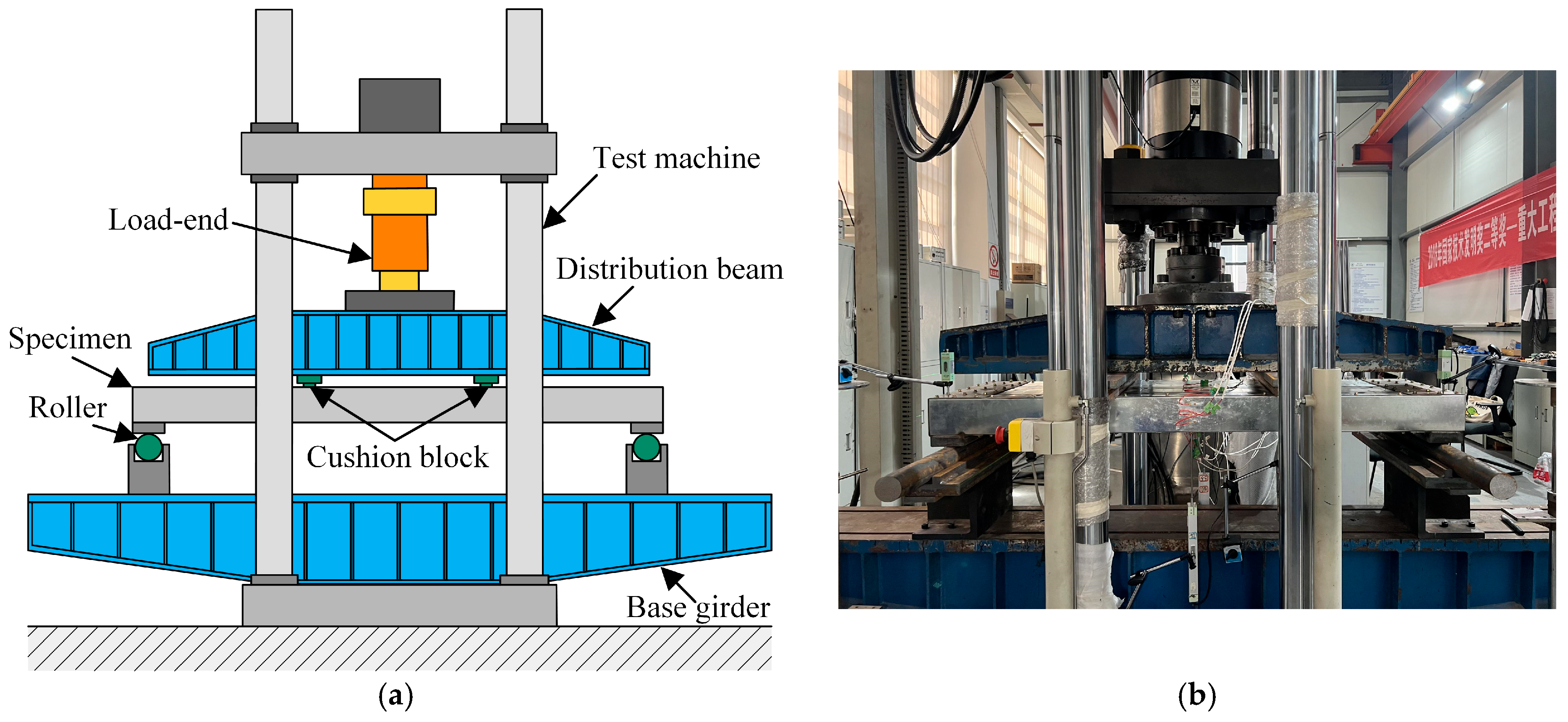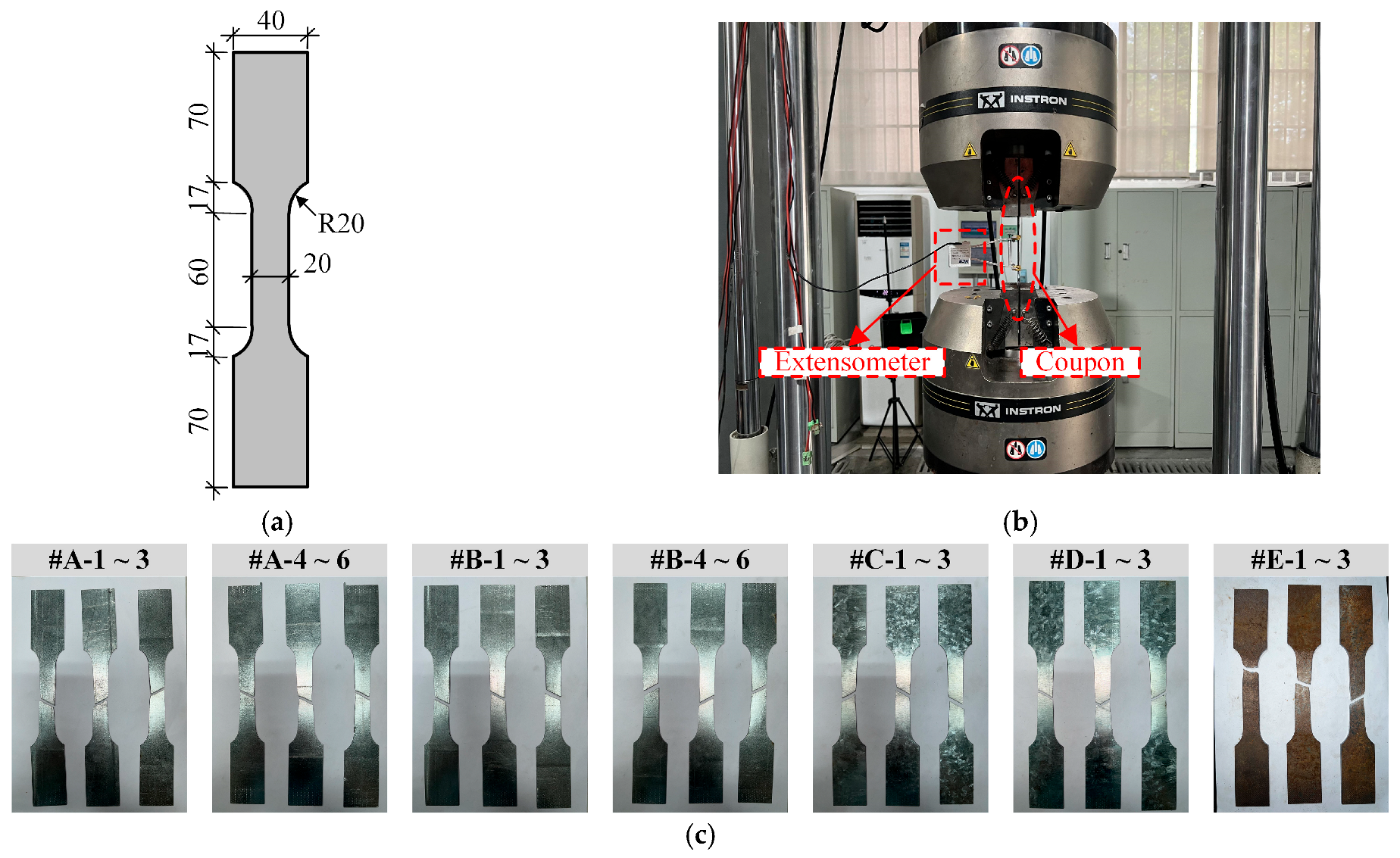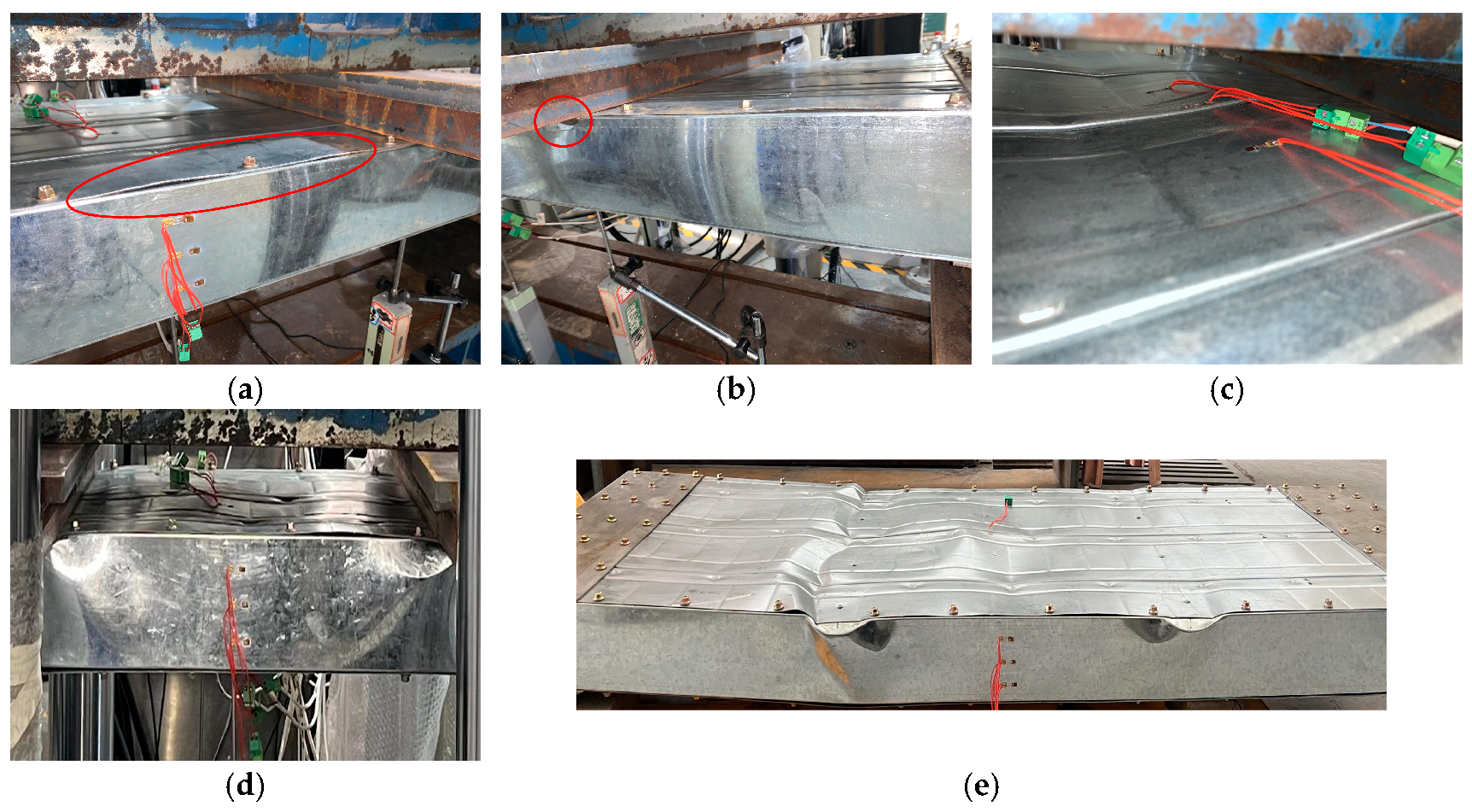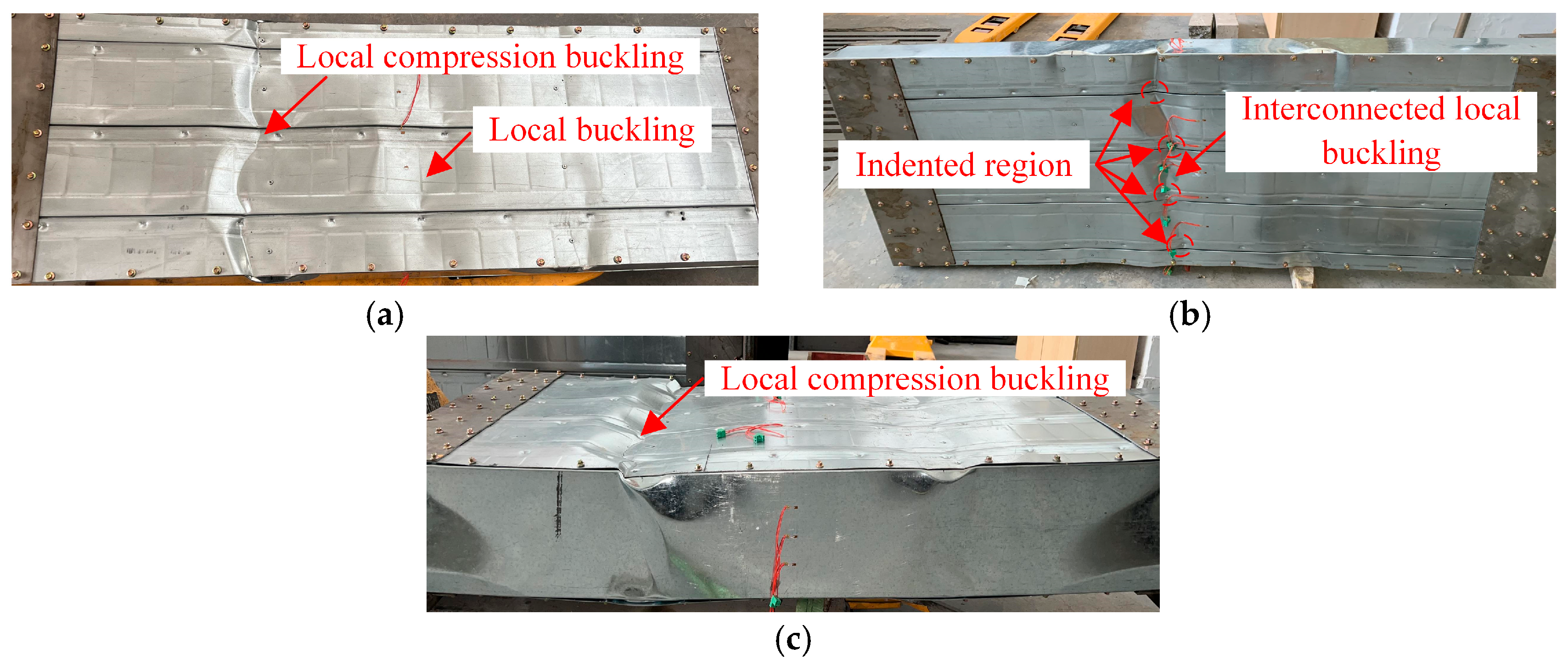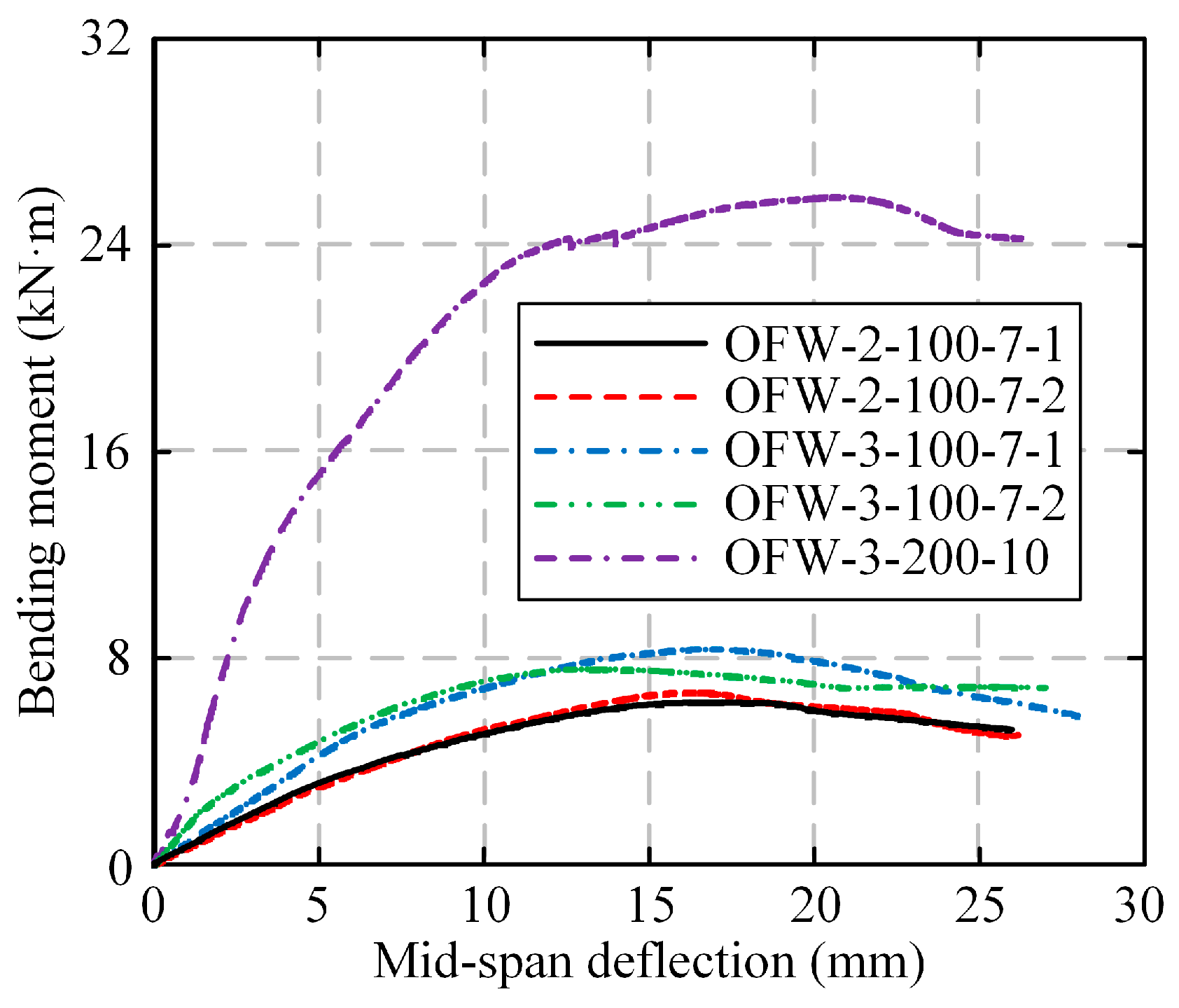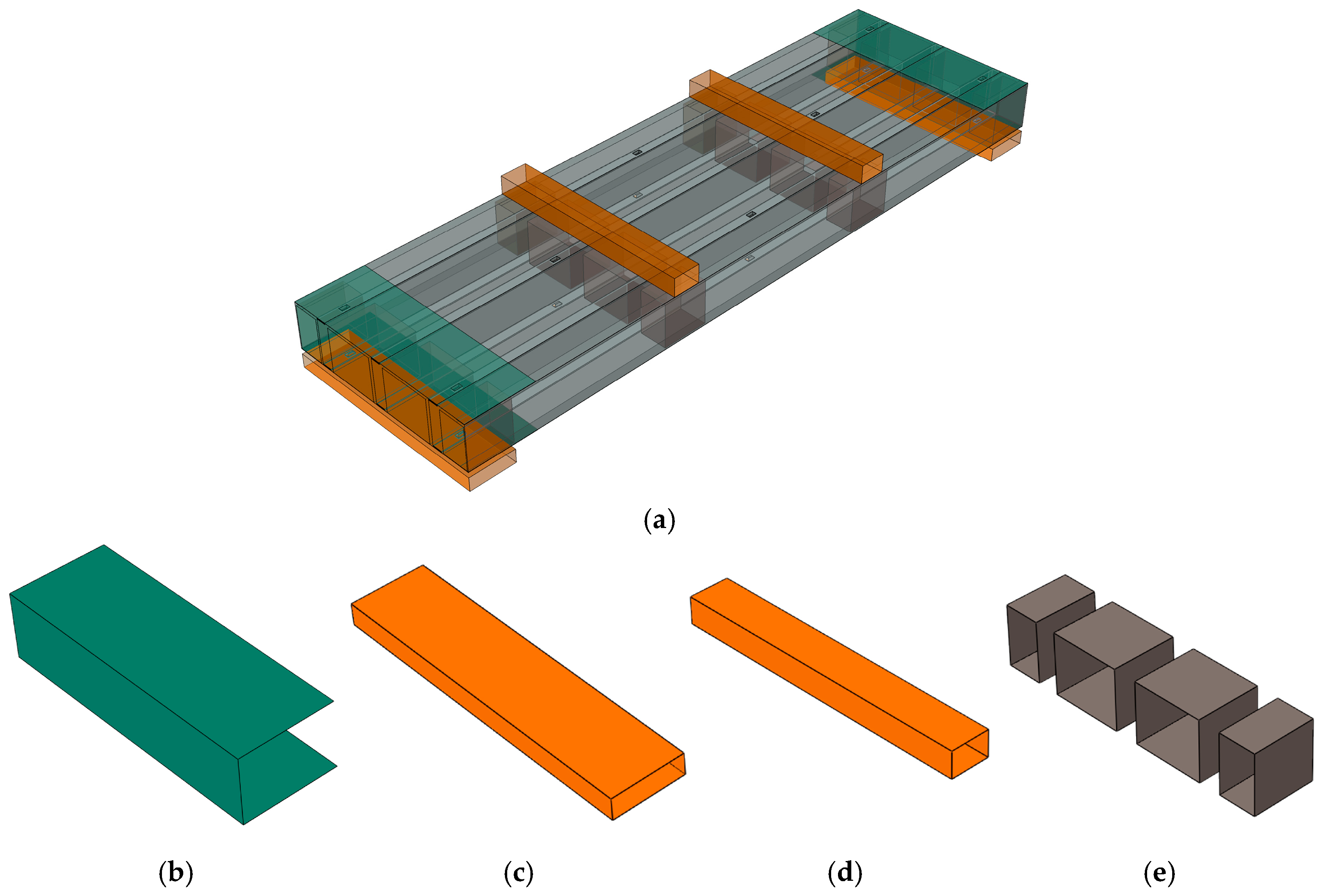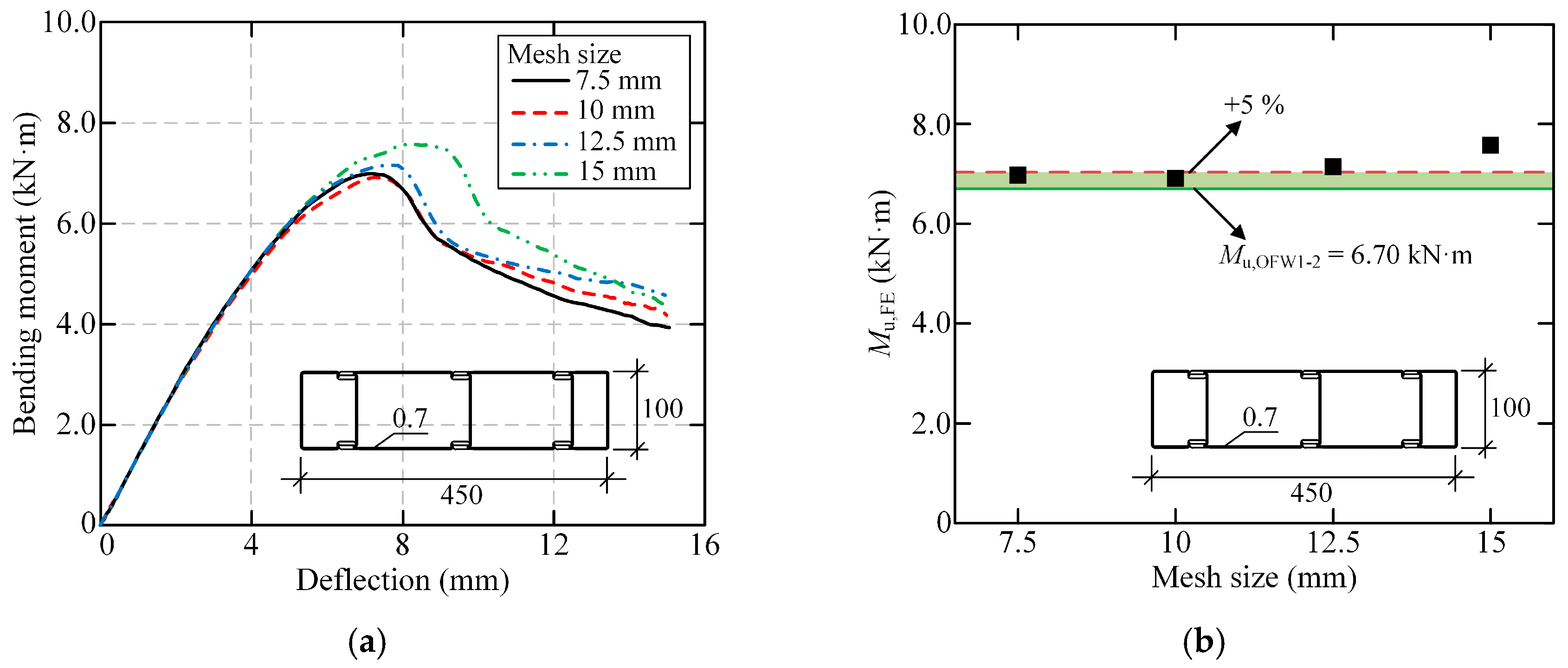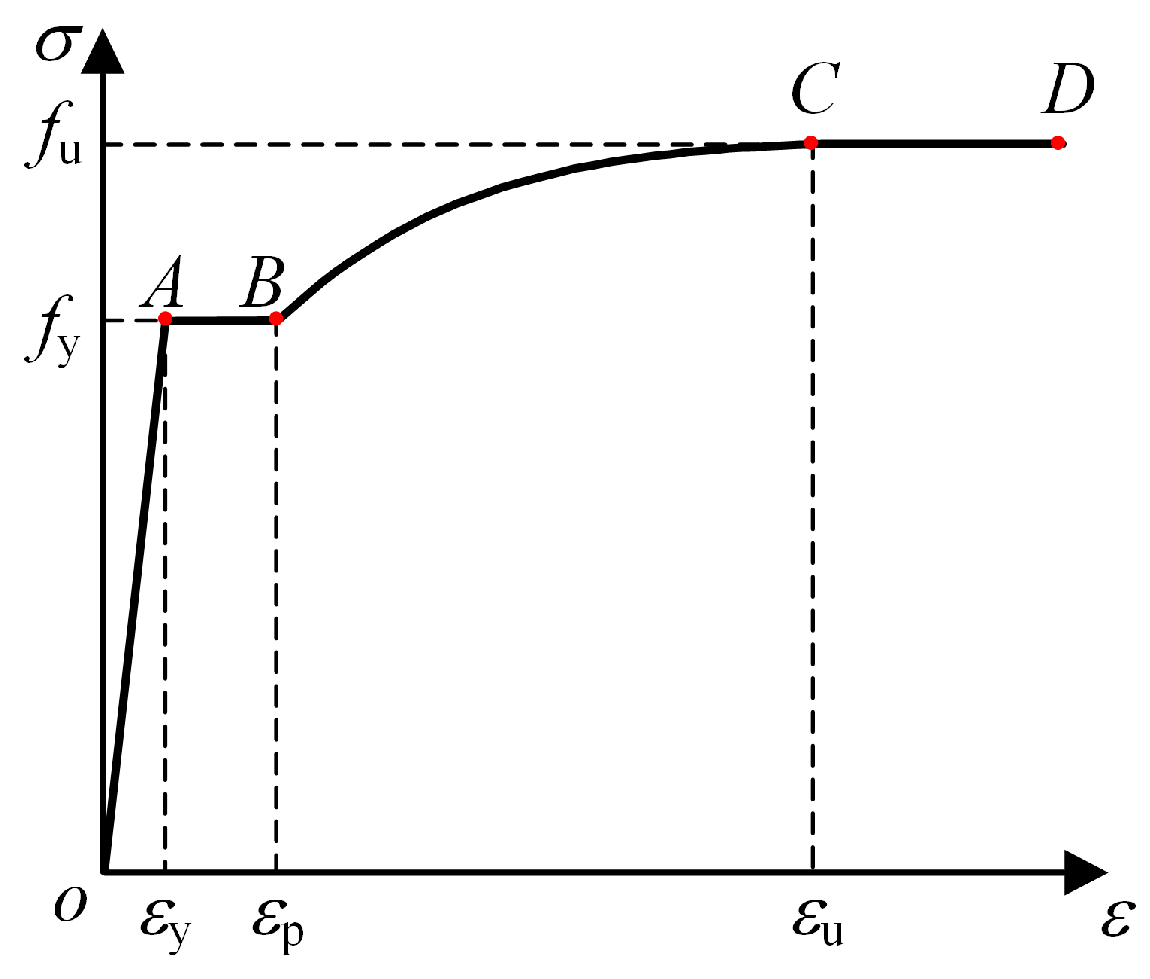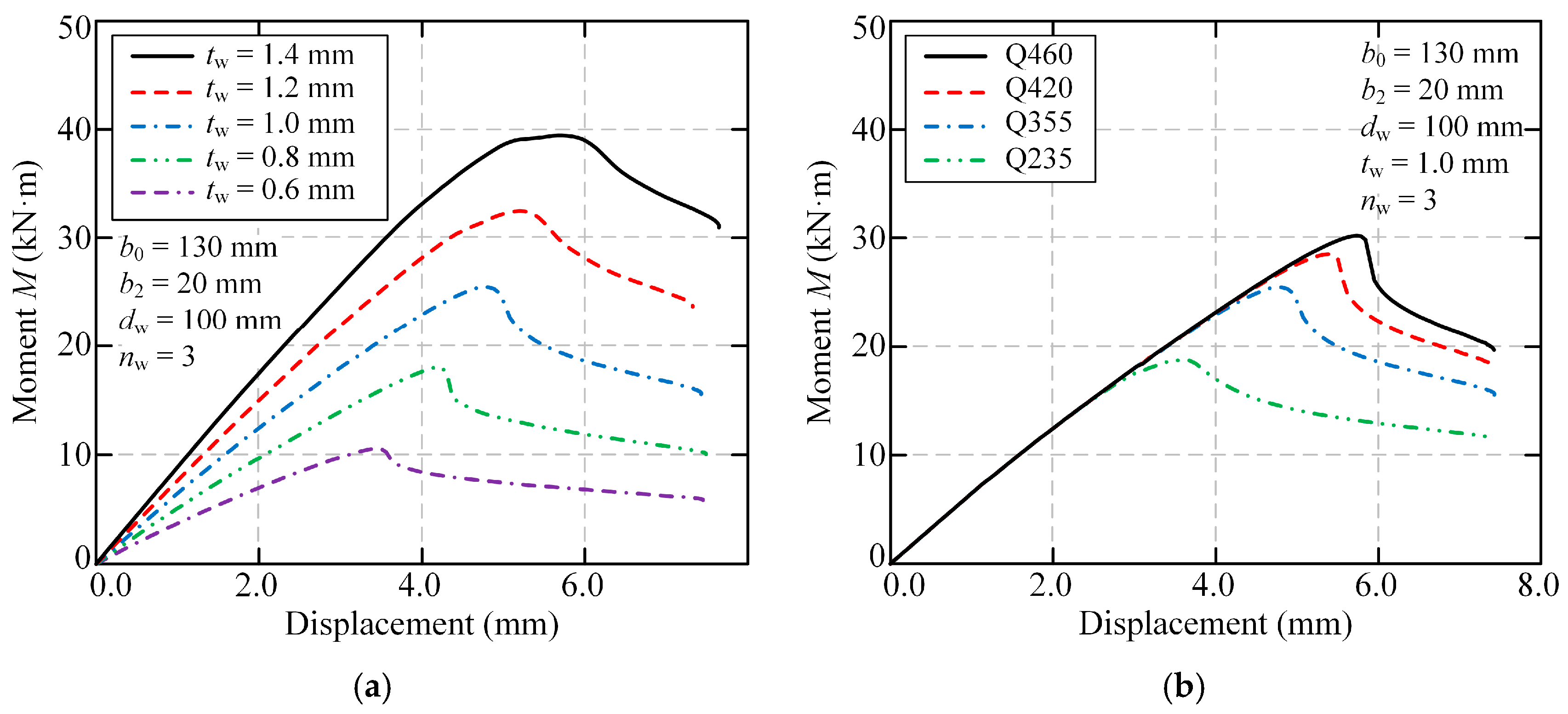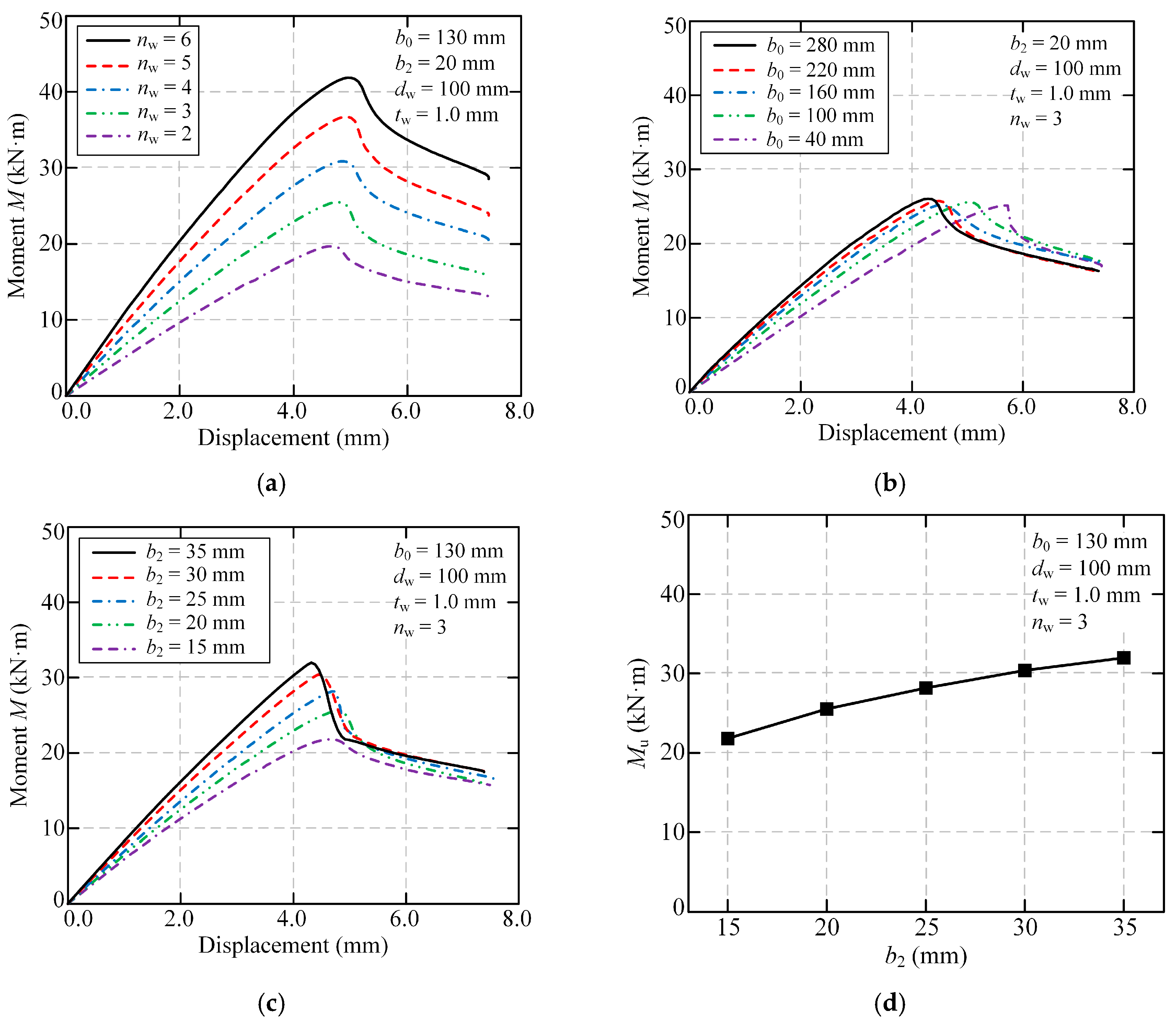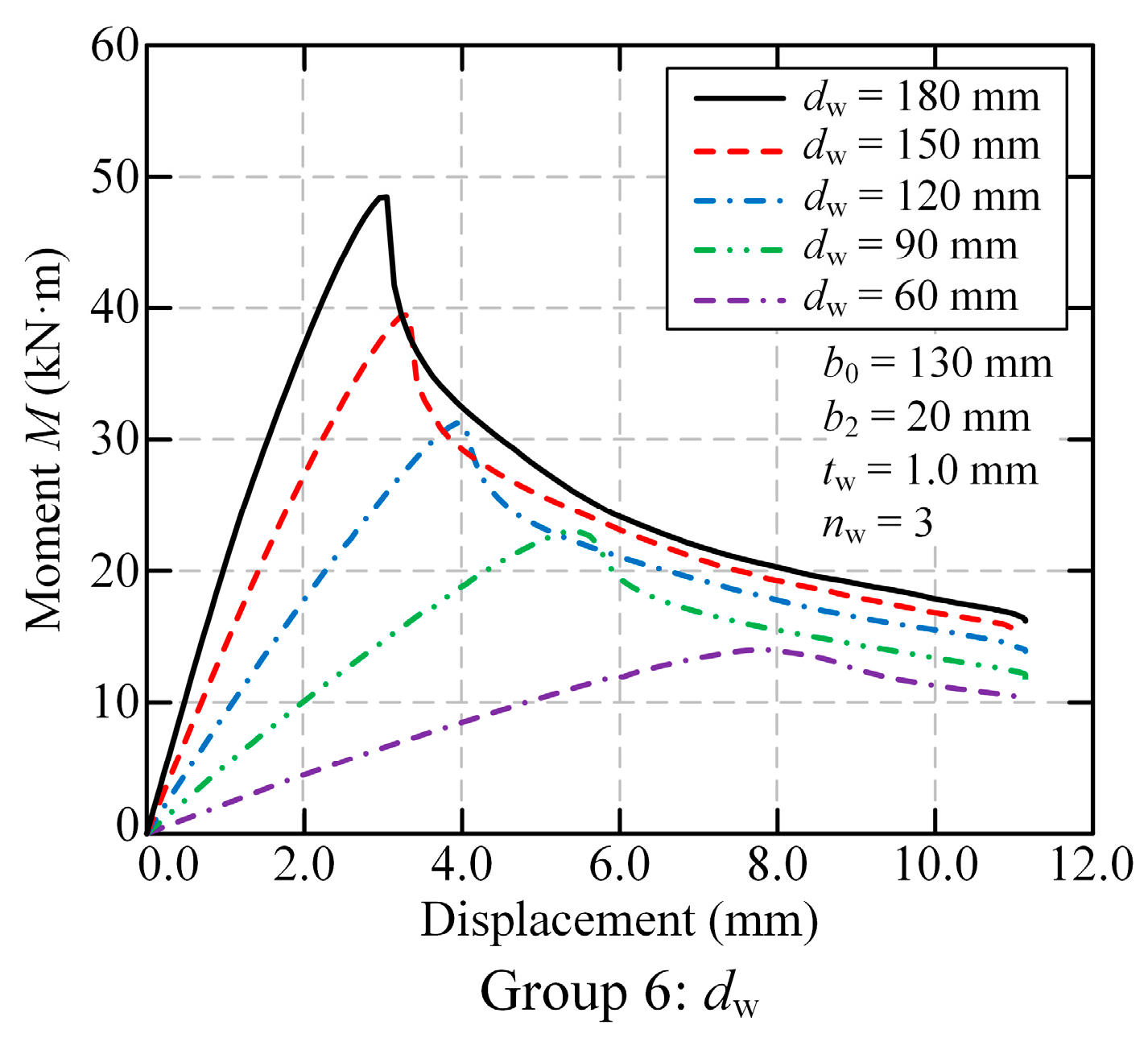1. Introduction
This section outlines the research background and motivation for investigating the flexural behavior of the fold-fastened multi-cellular steel panel (FMSP). It begins by reviewing the applications and limitations of conventional cold-formed steel (CFS) members, and then introduces the novel FMSP system as a solution. Finally, it clearly states the objectives and scope of the present study.
Compared to concrete structures and steel frames, cold-formed thin-walled steel (CFS) exhibited favorable attributes such as economic viability, low self-weight, simplified construction, and notable seismic resistance [
1,
2,
3,
4]. These advantages made CFS an ideal choice for cost-effective construction and sustainable development, particularly in multi-story residential building construction and retrofitting, where its economic efficiency and factory production characteristics could be fully leveraged. Consequently, CFS attracted significant attention from numerous engineers and researchers. Common single-limb CFS members included C-, U-, box-, angle-, and circular-sections. However, in practical engineering applications, single-limb members often proved inadequate to meet structural bearing capacity requirements. To address this limitation, C-, U-, and box-sectional members were typically used as basic components and connected with self-drilling screws to form built-up members, whose common cross-sectional configurations are illustrated in
Figure 1.
In recent years, extensive research has been conducted to explore the member performance of cold-formed thin-walled steel (CFS) [
5,
6]. For single-limb members, foundational contributions were made [
7,
8,
9,
10,
11,
12,
13]. A series of experimental and numerical analyses focusing on global, local, distortional, and interactive buckling of C-section beams were carried out [
14,
15,
16,
17]. Wang et al. [
18] and Zhang et al. [
19] numerically and experimentally investigated the flexural behavior of channel-section beams, while Li et al. [
20] conducted a series of four-point bending tests and extensive numerical simulations to study the flexural behavior of box-section beams.
For built-up I-section members, Zhou et al. [
21] and Yao et al. [
22] carried out comprehensive experimental and numerical analyses, examining the ultimate bearing capacity and failure modes under bending moments. They proposed a flexural capacity formula based on the effective width method (EWM) and verified its accuracy and applicability. Phan et al. [
23] revealed the influence of self-drilling screw connections, welding, and bolted connections on the bending stiffness of such members. Through experimental research, Chen et al. [
24] found that built-up I-section members with stiffening holes exhibited higher flexural capacity than those without openings. Roy et al. [
25,
26] explored the effect of spacing between individual limbs on the flexural capacity of built-up I-section members. Phan et al. [
27,
28] further conducted tests and numerical analyses on the flexural capacity of three-limb and four-limb complex built-up I-section members, finding that mono-symmetric sections were more susceptible to flexural-torsional buckling compared to doubly symmetric sections. Li and Young [
29] investigated built-up I-section and box-section members subjected to uniform and non-uniform minor axis bending, revealing their flexural behavior under moment gradients. They developed a predictive formula through numerical simulation and the direct strength method (DSM). Wang and Young [
30,
31,
32] studied the flexural capacity and failure modes of various built-up I-section and box-section beams under three- and four-point bending, leading to calibration of the DSM. Their subsequent work experimentally examined members with web openings, further refining the DSM to account for hole effects.
For built-up box-section members, Serrette [
33] experimentally studied the flexural behavior of built-up box-section members under eccentric loading, observing interactive torsional-flexural buckling and noting reduced capacity due to load eccentricity. Xu et al. [
34] analyzed the flexural capacity of such members under eccentric compression, examining influences of material strength, flange width-to-thickness ratio, and section height-to-width ratio. Li et al. [
35] conducted strong- and weak-axis bending tests, proposing a simplified flexural capacity formula. Selvaraj and Madhavan [
36] investigated the effects of member length and spot weld spacing on built-up box-section capacity through flexural tests, evaluating existing design methods and proposing improved formulas. Anbarasu and Karthik [
37,
38] numerically analyzed flexural behavior using ABAQUS, modifying existing DSM-based code provisions. Karthik et al. [
39] performed three- and four-point bending tests on built-up box-section members, characterizing flexural behavior and evaluating relevant design codes.
Based on the preceding summary, it is evident that extensive research has been conducted on both single-limb and built-up CFS members. However, several limitations associated with self-drilling screw connections can be identified. First, these connections require substantial on-site manual labor, significantly prolonging construction timelines and hindering fully assembled, industrialized production. Second, the discrete distribution of screws creates discontinuities at contact surfaces, compromising structural integrity. Third, the mechanical influence of screws must be carefully accounted for, increasing the complexity of structural design. Finally, built-up members are predominantly applied as column elements, with limited flexibility in sectional dimensions and cell configuration, rendering them insufficient for meeting the demands of complex engineering applications.
A novel CFS built-up closed section member, namely the fold-fastened multi-cellular steel panel (FMSP), was introduced. As shown in
Figure 2, the FMSP was composed of edge and basic members, which were connected by fold-fastened regions formed by mechanical embedding of hook-shaped and groove-shaped regions. The proposed FMSP directly addressed these limitations [
40,
41,
42]: (1) The fold-fastened connection was achieved through an automated mechanical fold-fastened process, which drastically reduced on-site manual labor and enabled a higher degree of prefabrication and industrialized production. (2) The continuous, interlocking hook-and-groove connection created a unified force transfer path, mitigating the stress concentrations caused by discrete screws and thereby enhancing the overall structural integrity and continuity. (3) By eliminating the need to model individual screw connections and their localized effects, the FMSP simplified the structural design process. (4) The modular nature of the FMSP allowed it to be flexibly configured as beams, columns, walls, and floors by varying the cell number, as demonstrated in the experimental program (Table 1), thus providing a versatile solution for complex engineering projects beyond the scope of traditional column members. FMSP has been applied in prefabricated buildings, as shown in
Figure 3.
The pursuit of such innovative connection techniques was aligned with the broader research trends in the CFS community, which focused on enhancing not only the structural performance but also the sustainability and digital design capabilities of modern construction systems. Recent studies have emphasized integrated structural and energy performance [
43], high-fidelity numerical modeling of flexural behavior [
44], and data-driven strength prediction [
45]. The present study complemented these directions by: (1) establishing and validating a refined finite element model with high accuracy for this novel system; and (2) generating a reliable experimental dataset that can support the development of future data-driven models.
When FMSPs were used as wall or floor members, they would inevitably be subjected to out-of-plane bending moments. Therefore, to expand the application range of the FMSP, it was extremely important to study its flexural bearing capacity. In this paper, the flexural bearing capacity of the FMSP was studied by four-point bending tests and simulations. The main contributions of this study were summarized as follows: (1) Experimental observation revealed a characteristic failure mode involving local buckling at the mid-span upper flange, accompanied by local compression at loading points. It was further discovered that overly deep indented regions could lead to unfavorable interconnected local buckling, leading to the design recommendation for a staggered layout. (2) A refined FEM was established and validated against test results, demonstrating excellent accuracy in replicating failure modes and bearing capacity, with computational errors primarily within ±5%. (3) A systematic parametric study quantified the influence of critical design parameters. The results showed that the ultimate flexural capacity exhibited a near-linear increase with the panel thickness, the steel plate thickness and cell number, whereas widening the panel or the fold-fastened region yielded diminishing returns. (4) Based on the findings, practical design advice was provided, including the avoidance of excessively wide fold-fastened regions and the prioritized use of increased panel thickness and plate thickness to efficiently improve flexural performance.
4. Finite Element Modeling
This section elaborates on the development, validation, and application of the refined finite element model. It details the model setup—including element selection, mesh sensitivity, boundary conditions, and material constitutive law—followed by a rigorous validation against experimental results. The validated model is then employed for an extensive parametric analysis to investigate key influencing factors.
4.1. Development of FEM
4.1.1. Element and Mesh
The refined FEMs were established by using ABAQUS 6.14. The geometric model was mainly composed of the FMSP, the end channel steel, the loading block, the bearing block, and the inner wooden block, as shown in
Figure 14. Considering that the thickness of the steel plate was much smaller than the overall structural dimensions, and the stress in the thickness direction could be ignored, the S4R shell element was selected, which was defined with five integration points through the thickness and capable of accommodating shear deformation along that direction [
51,
52,
53,
54]. To better obtain the stress and deformation of the fold-fastened region, the mesh refinement was carried out, and the local mesh size was taken as 5 mm (along the x-axis), as shown in
Figure 15.
Taking OFW-2-100-7-2 as an example, four different overall mesh sizes of 7.5, 10, 12.5, and 15 mm were selected. The corresponding bending moment–deflection curves are presented in
Figure 16a. It could be drawn that the initial stiffness and variation trend of each curve were consistent. When the overall mesh size was greater than 10 mm, the bearing capacity was significantly affected. When the overall mesh size was not more than 10 mm, the bearing capacity was rarely affected by the change in mesh size, and the error between the numerical and experimental results of OFW-2-100-7-2 was within ±5%, as shown in
Figure 16b. Therefore, it was considered that the numerical results were convergent with a mesh size of not more than 10 mm. To balance the computational efficiency and accuracy, 10 mm was reasonably selected as the overall mesh size.
4.1.2. Interactive Property
For the accuracy of numerical analysis, surface-to-surface contact was used to simulate the interaction between plates. The normal direction with finite slip was defined as hard contact. The tangential direction was defined as the coulomb friction model, and the penalty function method was adopted to ensure the coordination of the contact surface, and the friction coefficient was 0.2 [
55]. Due to the welding of the end channel steel and the bearing block in the test, in which the tie constraint was set. In addition, mesh-independent fasteners were utilized to simulate the additional self-drilling screws during specimen processing [
56,
57].
4.1.3. Boundary Condition and Load System
To ensure consistency between the boundary conditions of the FEMs and tests, the translational degree of freedom (DOF) along the
z-axis (
uz) and the rotational DOF around the
x-axis (
urx) of the lower surface centerline of the left bearing block were released, while all other DOFs were constrained. Similarly, the rotational DOF around the
x-axis (
urx) of the lower surface centerline of the right bearing block was released, while all other DOFs were constrained. Simply supported boundaries could be achieved by the above methods. Reference points (RPs) were established at the center points of the upper surfaces of the loading blocks, and they were coupled with their corresponding upper surfaces. The loading process was simulated by applying displacement loads in the
y-direction to the RPs. The specific boundary condition is detailed in
Figure 15.
4.1.4. Initial Geometric Imperfection
Initial imperfections were usually divided into geometric and residual stress initial imperfections. For the geometric initial imperfections, the imperfection amplitude was taken as 0.34
tw [
58] (
tw was the thickness of the steel plate). This magnitude was introduced into the FEMs by superimposing the first-order elastic buckling mode shape.
For the residual stress imperfections, Young and Rasmussen [
59] proposed that the residual stress and the increase in material yield strength caused by cold-formed processing had opposite effects on the bearing capacity, and the effects of the two offset each other. Given this, the influence of residual stress and cold-formed effect on the flexural bearing capacity was ignored in the FEMs.
4.2. Material Constitutive Model
The selection of appropriate constitutive relations played a decisive role in the accuracy and efficiency of numerical calculation. Referring to the existing research, the constitutive model of steel, which was proposed by Tao et al. [
60], was adopted in the FEM. The stress-strain relationship curve is shown in
Figure 17, where
fy and
fu are the yield strength and ultimate strength, respectively;
εy is the yield strain;
εp is the end strain of the yield platform and the initial strain of the strain hardening stage;
εu is the ultimate strain. In the simulation, the model parameters (yield strength, ultimate strength, etc.) were directly calibrated using the average values from the tensile coupon tests, as shown in
Table 5. This calibration ensured that the stress-strain relationship in the FEM accurately reflected the actual material behavior of the steel used in the specimens, including the yield plateau and strain hardening. Considering that the inner wooden blocks and cushion blocks were mainly compressed and deformed less during the test, they could be used as rigid bodies compared to the panel.
4.3. Validation of FEM
4.3.1. Failure Mode
The comparison between the numerical and experimental results of the failure modes of OFW-2-100-7 is shown in
Figure 18a. It could be observed that the failure modes of the FEMs were similar to the experimental results, such as local buckling at the midspan and local compression deformation at the loading location. After removing unnecessary components, the stress distribution and deformation of the FEMs at the later stage of loading are shown in
Figure 19. It could be recognized that the maximum stress occurred in the web and fold-fastened region at the midspan, where the plates experienced significant deformation. The plates in the tensile region near the midspan experienced lower stress. The fold-fastened region at the midspan began to separate. The comparison of OFW-3-100-7 is shown in
Figure 18b, which presents good consistency. The stress distribution and deformation of OFW-3-100-7 were similar to OFW-2-100-7, as shown in
Figure 20.
The comparison between the numerical and experimental results of the failure modes of OFW-3-200-10 is shown in
Figure 18c. It could be observed that the failure modes of the FEM were similar to the experimental results, such as local compression deformation at the loading location and local buckling of the flange of the edge channel steel. The stress distribution and deformation of the FEM at the later stage of loading are shown in
Figure 21. It could be observed that the maximum stress and deformation in the FEM occurred in the loading location on the top surface, while the stress in the loading region on the bottom surface was relatively lower than that on the top surface but still higher than in other regions. The deformation in the mid-span region was relatively small, and the fold-fastened region remained intact.
4.3.2. Bending Moment–Deflection Curves and Flexural Capacities
As shown in
Figure 22a–c, the bending moment–deflection curves of the FEM are compared with the experimental results. It could be seen that the overall trend of the curves was consistent. Due to the initial imperfections and assembly errors of the specimens, the bearing capacity of FEMs was higher than the experimental results. As shown in
Figure 22d and
Table 6, the results indicated that the error between the numerical and experimental results was mostly within ±5%. Additionally, the R
2 values exceed 0.98 and the Mean Deviation values are below 5%, indicating an excellent agreement between the numerical and experimental responses.
Despite the excellent overall agreement, some potential variability and model uncertainties should be acknowledged. The primary source of variability stems from initial geometric imperfections in the actual specimens, which, although considered in the model, have a complex and stochastic nature. Furthermore, minor assembly gaps and slight variations in the contact conditions are challenging to model with perfect fidelity. These factors are believed to contribute to the slight overestimation of initial stiffness in some FEM predictions. Nonetheless, the excellent agreement in ultimate capacity and failure modes confirms the model’s robustness for strength and parametric studies.
4.4. Parametric Analysis
As shown in
Table 7, six sets of numerical examples were established, which were numbered Groups 1–6, respectively, to further study the effect of different design parameters on the flexural behavior of FMSPs and provide valuable reference for practical engineering applications. The elastic modulus
E of the steel was 206 GPa, and Poisson’s ratio
ν was 0.3.
4.4.1. Steel Plate Thickness tw and Steel Strength fy
The effects of steel plate thickness
tw and steel strength
fy on the flexural behavior of FMSPs are described in
Figure 23. In
Figure 23a, it could be found that as the steel plate thickness increased, the initial stiffness increased significantly. In addition, when the steel plate thickness increased from 0.6 mm to 0.8, 1.0, 1.2, and 1.4 mm, the ultimate flexural capacity increased by 70.33%, 140.93%, 206.72%, and 272.57%, respectively. The enhanced performance with increasing steel plate thickness
tw is attributed to two fundamental mechanical principles: (1) improved local buckling resistance due to reduced width-to-thickness ratios, allowing sections to further utilize their material capacity, and (2) increased sectional modulus that directly enhances moment capacity. Therefore, in the practical design of FMSPs, choosing thicker steel plates could yield favorable mechanical performance.
In
Figure 23b, it could be observed that the initial stiffness was not influenced by steel strength. In addition, as steel strength increased, the rate of load reduction in the post-peak stage became faster. Additionally, as the steel strength increased from 235 MPa to 355, 420, and 460 MPa, corresponding to an increase of 51.06%, 78.72%, and 95.74%, respectively, the ultimate flexural capacity only increased by 36.02%, 52.06%, and 61.14%, respectively. This suggested that the increase in steel strength yielded a lower benefit in improving ultimate flexural capacity. The diminishing returns from higher steel strength
fy result from the strength-stability interaction in thin-walled sections. As material strength increases, local buckling often governs failure before the material yield strength is fully utilized, explaining the sub-proportional capacity gains.
4.4.2. Panel Width
The panel width was determined by the cell number
nw, the plate width
b0, and the width
b2 of fold-fastened regions. From
Figure 24a, it could be drawn that when the cell number
np increased from 2 to 6, the increments of ultimate flexural capacity were 5.85, 11.20, 17.60, and 22.21 kN·m, respectively. Therefore, it could be concluded that when
nw increased, the ultimate flexural capacity increased linearly. The linear relationship between cell number
nw and flexural capacity stems from the direct proportionality between additional cells and sectional moment of inertia.
As shown in
Figure 24b, as the plate width increased from 40 mm to 100, 160, 220, and 280 mm, corresponding to an increase of 150%, 300%, 450%, and 600%, respectively, the ultimate flexural capacity increased by 1.79%, 1.43%, 2.45%, and 3.58%, respectively. It could be observed that the significant increase in plate width has minimal influence on the ultimate flexural capacity of the FMSP. This was because when the panel width increased, the increment in the effective width of the plate was not significant. The minimal effect of plate width
b0 expansion reflects the effective width concept in cold-formed steel design, where portions of wide flanges become ineffective due to local buckling.
As shown in
Figure 24c, the ultimate flexural capacity increased by 17.07%, 29.22%, 39.43%, and 46.74%, respectively, with the proportional increase in the width of fold-fastened regions, and the increase rate of the ultimate flexural capacity gradually decreased. As shown in
Figure 24d, the slope of the line decreased with the increase of
b2. The diminishing benefits of wider fold-fastened regions
b2 occur because these regions act as elements susceptible to local buckling, limiting their contribution to overall section performance. The impact of this effect would be more pronounced when dealing with thinner steel plates, thus emphasizing the need to avoid excessively wide fold-fastened regions in practical engineering scenarios.
4.4.3. Panel Thickness dw
As shown in
Figure 25, as the panel thickness
dw increased from 60 mm by 50%, 100%, 150%, and 200% to 90, 120, 150, and 180 mm, the ultimate flexural capacity increased by 64.11%, 123.16%, 181.56%, and 246.18%, respectively. The exceptional effectiveness of increasing panel thickness
dw follows from the fundamental bending theory, where section modulus increases with the square of the section height. This mechanical principle explains why panel thickness enhancement provides an efficient means for improving flexural performance in FMSPs.
4.5. Design Implications and Optimization Guidelines
Based on the parametric analysis and underlying mechanical principles, the following design recommendations are proposed for practical FMSP applications:
Priority parameters for flexural capacity optimization: Based on quantified results, the key parameters can be ranked by their effectiveness in enhancing ultimate flexural capacity as follows: increasing the steel plate thickness tw constitutes the primary strategy, being the most influential parameter, owing to the concurrent enhancement of the cross-sectional area and significant improvement in local buckling resistance of all plate components; increasing the panel thickness dw serves as the secondary strategy, providing a substantial 123% improvement upon doubling; finally, increasing the cell number nw represents a tertiary strategy, delivering a near-linear gain in capacity while offering added flexibility for architectural adaptation.
Parameters with limited benefits: In contrast to geometric parameters, modifications to material and connection properties yield progressively diminishing returns: enhancing the yield strength fy provides limited structural benefit and should only be considered after geometric optimization; expanding the flange width b0 offers minimal improvement and should be governed primarily by connection requirements; meanwhile, increasing the fold-fastened region width b2 requires careful optimization for connection integrity rather than indiscriminate enlargement to prevent local buckling.
Practical optimization pathway: For an efficient and cost-effective design process, engineers are recommended to first optimize the steel plate thickness tw to meet the target flexural capacity, as it provides the highest performance gain per unit increase; then adjust the panel thickness dw to further finetune the capacity and stiffness, leveraging its substantial influence; subsequently configure the cell number nw to achieve the required sectional width and accommodate architectural layout needs; and finally select a standard steel grade fy based on material availability and cost-effectiveness, rather than relying on high-strength steel for primary capacity improvements.
